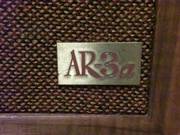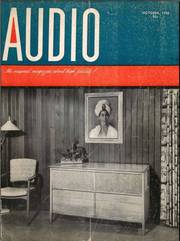Der Autor Edgar M. Villchur war der President von AR
Mit "AR" ist die "Acoustic Research, Inc." gemeint und Edgar M. Villchur war der Chef. Dazu muß man wissen, in USA war schon immer der Chef - selbst der Chef der kleinsten Klitsche - der President oder ein President. - Als ich 1985 zum ersten Male nach USA geflogen bin, wurde mir von USA erfahrenen Freunden dringend angeraten, mir "amerikanische !!" Visitenkarten machen bzw. drucken zu lassen. Da müsse unbedingt "Gert Redlich - President " drauf stehen, sonst bekäme ich nicht mal einen Kaffee angeboten. Ich jedenfalls tat mich schwer damit, ließ die aber dennoch drucken. Und es stimmte. Jede Klitsche hatte einen Presidenten. Der General Manager - also bei uns der Geschäftsführer - zählte dort drüben überhaupt nichts.
.
New High-Frequency Speaker
Reprinted from AUDIO • October 1958
Edgar M. Villchur - Acoustic Research, Inc., 24 Thorndike St., Cambridge 41, Mass.
The author describes a new approach to high-frequency speaker design, resulting in what he calls a "distillation" of tweeter construction to the simplest device possible. Using neither spider, cone, nor horn, this hemispherical radiator is used in the AR-3 speaker.
Introduction
It is generally agreed that the loudspeaker is still the weakest link in the chain of sound reproducing components, and therefore in most need of improvement. Irregularities in frequency response, transient ringing associated with peaks and dips in the response curve, distortion, and progressive beaming of the higher frequencies are well known deficiencies.
These deficiencies, as recorded objectively by measuring equipment, are associated with definite subjective effects. It is possible, with experience, to predict quite accurately the type and degree of coloration that a speaker will impose on the music it reproduces, given sufficient objective data. Unfortunately such information is rarely if ever available to the consumer; there is also considerable work yet to be done in validating and standardizing speaker-measurement techniques that will give meaningful information to the prospective user.
Die Frequenzgang-Kurve sagt überhaupt nichts
An example of a speaker performance specification which tells an incomplete story is the on-axis frequency-response curve. Methods for recording such a curve are described in RETMA and ASA Standards1, and useful information is provided as to smoothness of response. But the treble balance of the speaker-whether it will be brilliant or dull, and whether it will convey the sense of space that existed in the original hall-is not adequately predicted: The on-axis curve does not tell us how much relative energy is radiated in the treble.
For example, a speaker with relatively flat on-axis response in the high-frequency region may show response 15db down 30 deg. off-axis; the total high-frequency power radiated must clearly be very much attenuated. Since a normally reverberant room tends to integrate on-axis and off-axis sound the final effect will be that of a speaker with attenuated treble response *2.
This attenuation could be predicted by a family of curves showing frequency response at different azimuth angles (both vertical and horizontal), or by a "power-response" curve which showed the actual relative power radiated at different frequencies for constant input.
Wichtig: Ein großer Abstrahlwinkel
Flat on-axis response combined with good dispersion - that is, uniform response over a reasonably large solid angle - apparently creates the right ratio of direct to reflected sound in the room so that a maximum sense of realism exists. Good horizontal and vertical dispersion does not merely determine that a speaker can be listened to off-axis; it strongly influences the sound anywhere in the room, including positions on-axis with the speaker. Without such dispersion the sense of the original hall acoustics is reduced, the total treble energy radiated is decreased, and awareness of the speaker as an artificial sound source of dimensions much smaller than an orchestra or choral group is sharpened.
Die erkennbare Punkt-Quelle
This last result is sometimes referred to as the "point-source effect", meaning that the sound seems to originate from a single point. It is an unfortunate term (unglücklicher Begriff) to use, because a true point-source - acoustically speaking - has perfect dispersion (Verteilung), while the larger the radiating diaphragm the sharper is the beaming of treble frequencies. It is the writer's experience that dispersion is the controlling element in the so-called point-source effect, and that a speaker with good dispersion least conveys the sense of sound issuing from a particular spot in the room.
Design of New Tweeter
The tweeter here described, derives from a sort of distillation of speaker design to the simplest device possible in terms of its basic function - that of converting treble electrical energy to acoustical energy with maximum uniformity of both on-axis and power response. A novice unsophisticated in the ways of current speaker construction might conceive of such a tweeter.
The dynamic type of speaker was chosen as an inherently simple one. Thus the moving force is provided by a voice-coil and magnetic structure, as shown in Fig. 1.
Die Wahl der Membrangröße
The introductory remarks of this article explain the choice of diaphragm size and shape - a section of a small sphere. Although such a diaphragm, subjected to longitudinal vibration as here, does not have the perfect dispersion characteristic of a pulsating sphere, its dispersion is good indeed.
Two sizes of phenolic diaphragm are used in the tweeter system, a 2" diameter and a 1 1/4" diameter (see Fig. 2.) The smaller unit has only slightly better on-axis response at the upper end of the audio spectrum than the larger one, but it does have better dispersion and power response above 7.000 cps. It will be noted that the dome shape makes a rim suspension device of the type used with cones (a skiver or surround) unnecessary.
Der Dome hängt direkt an der Schwingspule dran
The dome is attached directly to an aluminum self-supporting voice-coil, and the assembly is held in the gap by synthetic rubber material placed right in the gap. Two types of material are used; one a substance which foams up after insertion in the gap (anchored by four notches in the top plate), providing
the adhesion necessary to hold the voice-coil permanently in place, and the other a very compliant butyl which fills the remaining portion of the gap.
The latter keeps dust out, helps create positive centering, and provides a certain amount of damping, although the major burden of damping is borne by the electro-magnetic circuit. Chemicals had to be found that combined the proper performance qualities with stability over the years. Chemical changes with time, if any, are expected to increase compliance slightly rather than to stiffen the system.
Eine Dome ähnliche Membrane voller Glaswolle
Thus, the entire tweeter consists of a dome-shaped diaphragm filled with Fiberglas, a voice-coil (with pig-tail leads formed by its own wire ends), a magnetic structure, and suspending material in the gap. The Fiberglas in the magnetic structure is to damp out internal acoustical resonances which originally produced a response peak in the 500cps region.
Sie wiegt ganz knapp etwas mehr als 1 Gramm
Some of the speaker parts used in various types of current conventional tweeters but eliminated here are the skiver, the external spider, the voice-coil former, separate pig-tail leads and eyelets, the dispersing device, and the horn. The tweeter's moving system consists of only the diaphragm, voice-coil, and rubber suspension, and has a mass of slightly more than one gram.
Performance Measurements zum Vergleichen
It was felt that photographs of the actual automatic response traces (plus microphone calibration curves), published in addition to the final interpolated data, would provide greater interest than the digested data alone. Conditions of measurement are described in some detail and are in compliance with the existing American Standards previously referred to. This makes possible evaluation by the reader, as well as duplication of tests by other laboratories.
Tests im schalltoten Raum
The speakers were mounted with their top plates flush to the baffles, and were placed so that they radiated into a solid angle of 180 deg., into an anechoic chamber. For off-axis readings the baffle was turned in a horizontal plane. (Vertical dispersion was identical to horizontal by virtue of the symmetrical construction of the tweeters.) During azimuth readings the edges of the baffle, which was cut to the size of an AR-1 enclosure, were exposed and allowed diffraction effects.
Grundlagen der Messungen
The microphone was hung to receive the sound at grazing incidence - the condition for which the calibration curve applied - at a distance of 4% feet from the speaker. The tweeters were fed by an automatically repeating, one-second sweep signal from an amplifier with a damping factor of 15, and the output of the microphone fed to a cathode-ray tube screen with synchronized horizontal trace, over three separate ranges on a linear frequency scale, each range covering approximately 5000 cps. The division into three ranges, and the unfortunate use of a linear rather than a logarithmic frequency scale was dictated by the nature of the test equipment used. The sweep rate was validated as sufficiently low by comparing results to those made with a 1000 cps/second sweep.
Gemessen wird mit 1 Watt
The input voltage across the tweeters was 2 volts, representing 1 watt to the rated impedance of 4 ohms. It may be mentioned that the single-frequency sound levels produced Would be associated with a relatively high over-all level of musical sound.
The test equipment included the following :
- 1. Anechoic chamber (AR) that can be considered non-reverberant to an octave below the lowest frequency measured.
- 2. Panoramic Sonic Analyzer LPla, Sonic Response Indicator G2, and Power Supply PS1C.
- 3. Altec 21-BR-150 capacitor microphone, Serial No. 10386, with individual calibration curve supplied by Altec, with Altec Microphone Power Supply P526A.
- 4. Dynakit Mark III power amplifier.
- 5. Dumont Oscillograph-Record Camera type 302.
- 6. Krohn-Hite Oscillator 430-AB.
.
Figure 3 is a combined photograph of the on-axis response traces of the 2-inch unit (124 M-f capacitor in series), with
the three frequency ranges juxtaposed. The microphone calibration curve, transposed to a linear scale, is drawn in above the trace in dashed lines.
Figure 4 combines photographs of the on-axis response traces of the 1%-inch unit (6 M-f capacitor in series) over the
two higher ranges, again with the microphone calibration curve above.
The response of the tweeters above 15 kc is shown primarily to indicate smoothness in this range. The microphone was uncalibrated above 15 kc, but it can probably be assumed that microphone response continued the downward slope apparent in the calibration curve.
Dispersion - Schallverteilung
Figures 5 and 6 compare the on-axis response of the two tweeters with the response of 30 deg. and 45 deg. off-axis, each in its respective frequency range.
Figure 7 is not shown as a contrasting "horrible example", but merely to indicate that the measuring equipment is properly sensitive to speaker response irregularities when they exist. It is the response trace of a relatively low-priced but well made tweeter, comparably baffled.
Die finale Frequenzkurve ist sehr gut
The final response curves, shown in Fig. 8, represents the AR tweeter response traces corrected for microphone calibration and plotted on a standard 30 db/decade audio log scale.
It can be seen that the on-axis response of each unit in its range is uniform within narrow limits: ±2db for the 2" tweeter and ±1.5db for the 1 1/4" tweeter, unusual characteristics for loudspeakers. The off-axis losses of the 2" unit (apparently not too serious as determined by listening tests) are picked up by the smaller tweeter, and the off-axis response curves remain smooth, another unusual circumstance for loudspeakers.
Ein glatter Frequenzgang ohne Verfärbungen
Smooth frequency response is associated with reduced speaker coloration, clarity and definition of individual musical instruments, and subdued record surface noise even when there is considerable high-frequency energy radiated. Peaky response selectively emphasizes discrete frequency regions of surface noise, making it much more obtrusive.
Distortion, Efficiency and Power Capability
For response curves to be valid they must represent fundamental speaker output only. Validating harmonic distortion measurements were therefore made for the frequency ranges covered, at the same input power. The total harmonic distortion did not exceed 2 per cent at any frequency.
Die Hoch- und Tieftöner Balance
The efficiency of these units is slightly higher than that of an AR-1 woofer, and some attenuation is required for proper balance in typical rooms. Although the maximum single-frequency power capability was not determined, the tweeter system has been in constant use with an AR-1W woofer and Dynakit 60-watt amplifier, at high musical levels, without ill effect. Figure 9 shows the combination of AR-1 woofer and new tweeters in the AR-3 speaker system, with grille cloth removed.
Eine niedrige Effizienz des Hochtöners
This tweeter design is inherently low in electro-acoustic efficiency, and, at least in its present embodiment, it does not make for a very light or inexpensive unit. In spite of the very light moving systems almost 4 1/2 pounds of Alnico 5 and 8 pounds of high-permeability iron must be used in the combined units to achieve acceptable efficiency. On the other hand these tweeters were designed as a proposed solution to some of the problems of treble reproduction on an absolute basis, rather than as embodiments of a new price vs. quality formula. A patent application for the tweeter design described in this article is pending in the name of the author.
Bildunterschriften und Texte geparkt
Fig. 1 Structure of the tweeter.
Fig. 2. 2-inch and 1% inch tweeters, unmounted. (Photo by Bunker.)
Fig. 3. Photograph of the on-axis response trace (linear frequency scale) of the 2-inch tweeter. Microphone calibration curve is drawn in above. Marker pips at frequencies indicated.
Fig. 4. On-axis response trace of the 1%-inch tweeter, recorded as in Fig. 3.
Fig. 5. (left). Response of 2-inch tweeter on-axis (top), 30 deg. off-axis (middle), and 45 deg. off-axis (bottom).
Fig. 6. (right). Response of 1%-inch tweeter on-axis (top), 30 deg. off-axis (middle), and 45 deg. off-axis (bottom).
Fig. 7. Response of another tweeter on-axis (top) and 30 deg. off-axis (bottom), showing sensitivity of measuring equipment to frequency irregularities.
Fig. 8. (Top) Response curve of 2-inch tweeter on-axis, 30 deg. off-axis, and 45 deg. off-axis, corrected for microphone and plotted on audio log. scale. (Bottom) Same, 1%-inch tweeter.
Fig. 9. Prototype of AR-3 speaker system, including AR-1 acoustic suspension woofer and the two tweeters described in this article. (Photo by Bunker.)
*1 RETMA Standard SE-103 and ASA Standard C 16.4-1942.
*2 Arthur A. Janszen, 'An electrostatic loudspeaker development." p. 89, J.A.E.S., Vol. 3, No. 2, April 1955. The importance of treble dispersion to over-all sound quality has also been brought out in the design work of A. S. Hegeman.
*3 It may be of interest to note that the frequency of ultimate air-load resistance for the 2-inch diaphragm is approximately 4400 cps, and for the 1%-inch diaphragm 6600 cps. This implies that, even assuming pure mass control above these frequencies and complete diaphragm rigidity (neither of which assumptions holds entirely true) the total power response of the larger unit will be down only 6 db at 8800 ep3, and of the smaller unit 6 db at 13,200 cps.



